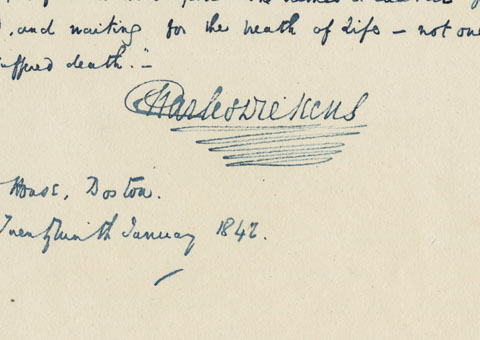Charles Dickens Arranges for the Publication of the Playbill for “Every Man in his Humour”, in Which He Himself Played a Role on Stage

The next year his correspondent, scientist Sheridan Muspratt, helped him raise money to support the acquisition of Shakespeare's House in Stratford-upon-Avon
Mark Lemon was a playwright who became the long time editor of Punch Magazine. Under Lemon’s guidance, Punch became an artistic, political, and financial success. It had considerable influence and was known for employing the most talented humorists and cartoonists in Britain. In April 1843 Lemon was formally invited to dinner by...
Mark Lemon was a playwright who became the long time editor of Punch Magazine. Under Lemon’s guidance, Punch became an artistic, political, and financial success. It had considerable influence and was known for employing the most talented humorists and cartoonists in Britain. In April 1843 Lemon was formally invited to dinner by Dickens and their friendship grew. Lemon and Punch stalwart Gilbert Beckett adapted Dickens’s “Chimes” for the Adelphi Theatre in February 1844. “The Haunted Man” followed. A shared passion for amateur theatricals cemented their friendship. Lemon appeared as Brainworm and Dickens as Bobadil in Ben Jonson’s “Every Man in his Humour”, which played at the Royalty and St. James Theatres in London in the autumn of 1845. The production was transferred to Manchester and Liverpool in the summer of 1847, and in the following year the play was revived in London, alternating with “The Merry Wives of Windsor”, in which Lemon appeared as Falstaff alongside Dickens.
In 1847, the London and Shakespeare Committee purchased Shakespeare’s House in Stratford-upon-Avon and wanted to appoint a suitable person to administer the birthplace. Dickens, who was a member of the Committee, then formed a touring amateur theatrical troupe in 1848 for the purpose of staging amateur theatricals in order to raise funds for an endowment for the curatorship of the house and then to install the dramatist Sheridan Knowles as the first incumbent. Two productions in aid of the project were held at the Haymarket in London and subsequently at Manchester, Liverpool, Birmingham, Edinburgh and Glasgow. Dickens took full responsibility for running the tour in the provinces and making all the administrative and publicity arrangements.
Sheridan Muspratt was a research chemist and author of the book, “Chemistry, Theoretical, Practical and Analytical as applied and relating to the Arts and Manufactures”. Dickens took an interest in Muspratt’s work, was “delighted” in it, and in turn Muspratt took an interest in theater. He helped to organize Dickens’ 1847 and 1848 theatrical troupe’s visits to Liverpool. Among the cast in the latter were the American actress Susan Webb Cushman, who Muspratt later married.
Autograph letter signed, London, July 22, 1847, to Muspratt, relating to the first visit to perform “Every Man in his Humour”, requesting that he get the final playbill to Mark Lemon at Punch to publish. “Will you have the goodness, by return of post, to send a proof of the last complete bill, addressed ‘Mark Lemon, Esquire, Punch Office, Fleet Street, London’? We wish to print it with the address.”
We wish to thank the Charles Dickens Papers for their kind assistance dating the letter and confirmation of its content. This is our first Dickens letter relating to a playbill for any of his performances.

Frame, Display, Preserve
Each frame is custom constructed, using only proper museum archival materials. This includes:The finest frames, tailored to match the document you have chosen. These can period style, antiqued, gilded, wood, etc. Fabric mats, including silk and satin, as well as museum mat board with hand painted bevels. Attachment of the document to the matting to ensure its protection. This "hinging" is done according to archival standards. Protective "glass," or Tru Vue Optium Acrylic glazing, which is shatter resistant, 99% UV protective, and anti-reflective. You benefit from our decades of experience in designing and creating beautiful, compelling, and protective framed historical documents.
Learn more about our Framing Services










































































































